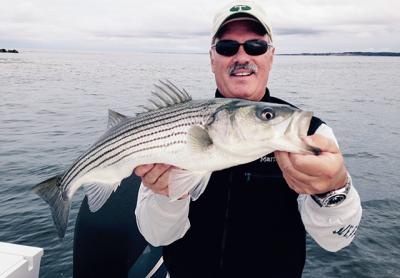Creating a Casting-Egg Rig

The bay anchovy is a small and translucent baitfish that typically arrives in great numbers around the East End in September. False albacore, bluefish, and striped bass aggressively feed on this one-to-three-inch prey species. It’s always a challenge for surfcasters to find a lure in their bag that matches the petite size and profile of a bay anchovy and can also be cast to fish feeding a nice distance from shore.
One sure way to send a small light lure a long distance is to utilize a casting egg, a one-to-two-ounce piece of painted solid wood in the shape of an egg that has small metal loops on each end. The casting egg was invented in the early 1950s by Jerry Sylvester, a prominent Rhode Island surfcaster, who wanted to deliver a small jig beyond a bar to early-season pollock feeding on a rocky bottom. Its use was quickly adopted by striped bass fishermen at the time and is very popular today with surfcasters in Rhode Island and Massachusetts. The casting egg is also used by New England spin fishermen to deliver a small fly to false albacore with lockjaw for tins and softbaits.
Rigging a casting egg is simple. The terminal end of the fishing line is tied to one of the egg’s metal loops and a three-foot section of 30-pound monofilament or fluorocarbon leader material is tied to the other loop. A fly or even a small bucktail, little swimmer, or light rubber jig is attached to the end of the leader to complete the rig. In many respects, a casting egg rig is just a bulked-up snapper popper.
The naturally aerodynamic shape of an egg allows it to punch through a wind and carry a fly or small lure deep into the surf. A casting egg rig can be worked a couple different ways. The angler can retrieve the floating egg at a slow to moderate pace allowing the churning waters to impart a lively action to the trailing imitation. Alternatively, the angler can fling the egg and let it float in place with the roiling surf providing erratic movement to the egg and the following fly or lure. The casting egg rig is particularly effective when fished over a shallow rocky area because it keeps the lure above underwater obstacles. Videos of anglers using the casting egg can be found online.
If you can’t find a casting egg locally, one can be purchased online from the Salty’s tackle shop in Massachusetts at saltwaterplugs.com or fabricated from wooden eggs found at craft stores or online. If you choose the latter route, make sure you are purchasing eggs that weigh at least one ounce individually. A poor-man’s third option is to remove the hooks from a floating plug and add a short leader to the rear hook loop or ring. Some anglers cleverly use a small piece of a wooden broom handle in place of a wooden egg.
We interrupt this fishing season for wind, wind, wind, and rain. Few boats if any left their docks and only the most hardcore surf anglers hit the beach during this recent spell of terrible weather. But those who ventured out to the Point to stand on rocks battered by 12-foot waves were rewarded with stripers up to 40 pounds, reported Ken Morse at Tight Lines Tackle in Sag Harbor. Ocean beaches were also productive but the strong current sweep required successful anglers to sling bucktails of up to four ounces, Morse added. Shinnecock Inlet was also a productive location, with 12 anglers hooking up simultaneously, according to one witness.
In addition to striped bass, weakfish were also taken from local beaches. Harvey Bennett at the Tackle Shop in Amagansett reported that a 15-pound fish was landed behind the Maidstone Club. False Albacore remain in the vicinity despite the rough conditions they typically disdain, Bennett added.
Green crabs beware. Blackfish season opened yesterday.
The Star’s fishing columnist can be followed on Twitter, @ehstarfishing. Photos of prize catches can be emailed to David Kuperschmid at fishreport@ ehstar.com.
